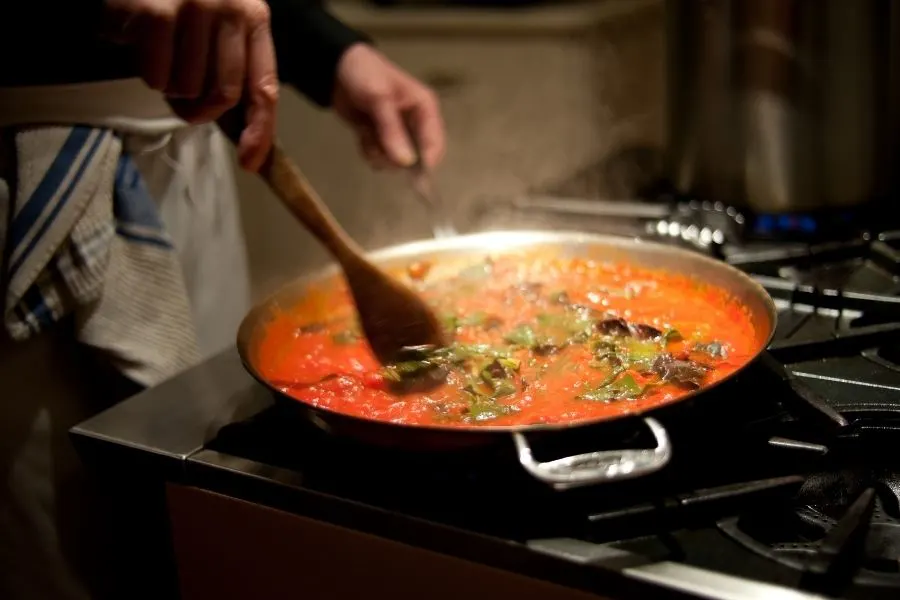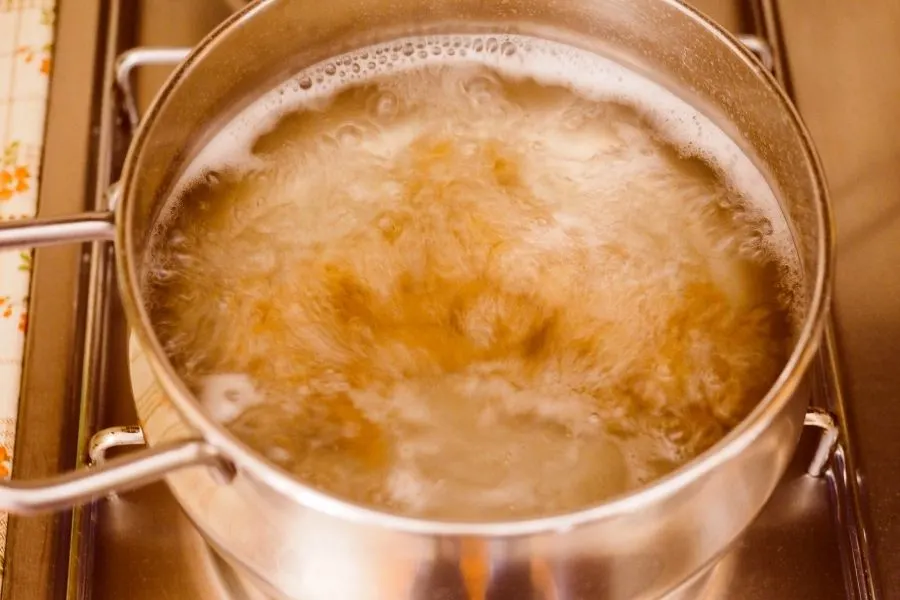Have you ever made pasta and have it come out bland ? It’s probably everyone’s nightmare. Soggy, cold pasta that doesn’t really taste like anything.
As it turns out, there’s a way to really improve your pasta’s flavor. And it’s as simple as changing when the sauce interacts with the pasta noodles.
For those who are professional pasta chefs, the question may sound silly, but what goes first: sauce in pasta or pasta in sauce ?
This little trick will really turn you whole pasta bowl around, and you’ll thank us for it.

Is it sauce in pasta or pasta in sauce ?
The right way to mix sauce and pasta is by adding pasta to the sauce. According to the Italian chef Gino D’Acampo, pasta should always be added to the sauce, and not the other way around.
This way the pasta will absorb all of the goodness from the sauce. It gets a nice, even layer of sauce that will make a difference in the bowl.
If you were to ass the sauce to the pasta, you’d end up with colder pasta and a very poorly flavored dish.
Read Also:White VS Red Sauce
Why add pasta to the sauce
If you put the pasta straight to a plate, it will cool down and become clumpy and icky. It wouldn’t be able to absorb flavor from the sauce.
So, pasta is added to the sauce to achieve maximum absorption of taste and even distribution of the whole dish’s flavor.
Moreover, putting pasta into a plate without sauce will make it dry. You would have to slather it with oil or butter to keep it fresh. You will be thus changing the recipe alongside adding in unnecessary fats.
The best way to do this is by adding al dente pasta to your hot sauce (turn off the heat). Toss the pasta in the sauce for a couple of minutes, being sure to coat everything.
Tips on how to sauce pasta properly
1. Make sure you cook the sauce first
To ensure you have the best pasta sauce, you should cook the sauce first before adding pasta.
If you keep the pasta waiting, it might overcook and become overly starchy. So, keep the sauce in a low simmer until your pasta is ready.
An added bonus to this is that the longer you cook your pasta sauce, the better it comes out. Especially true for tomato sauces like Ragu or Arrabbiata.

2. Don’t use too much sauce
You should go easy on the sauce, as sauce servings should be light.
On average, the sauce pasta ratio should be one and a half cups of sauce to one pound of pasta.
However for oil-based sauces, one cup is enough for one pound of pasta. If using cream-based sauces you can use even less sauce. You can thin it out to the right amount by using pasta water.
3. Keep the pasta water
The hot pasta water is essential as it is starchy. Therefore reserve at least one cup of it before draining the noodles.
This way you can thicken your sauce if you have to, with the already-present starch. Keep in mind that pasta will thicken the sauce once it comes into contact. The longer you let it sit, the more sauce it will absorb.

4. Use pasta water in the sauce
After adding the hot pasta to the sauce, add some reserved hot starchy water to the sauce if you need to. It would help if you did this in bits for the desired consistency.
If you need a thinner sauce, use the pasta water to achieve a thinner and lighter texture. And for oil-based sauces, you should use pasta water to bind and coat the noodles with the sauce.
The starch on cooked, hot pasta will emulsify the fats in the sauce and make them cling even better.
5. Don’t rinse the pasta !
Unless you plan to create a cold pasta salad or dish, you should not rinse your pasta.
If you do it will quickly cool down, and the sauce won’t have anything to grab onto. Rinsing removes the necessary starches that are responsible for adhering.
Additionally, don’t add oil to already cooked pasta. If your pasta is sticking it’s best to add some hot water to it and let it unstick. Or, throw it as-is into the very hot sauce and give it some gentle stirring until it comes apart.
6. Let them simmer together for a minute.
Cook the sauce and pasta together just a bit, for even distribution of flavor. With the help of the added starchy water, the flavor will develop and coat the pasta beautifully.
Now you can put your pasta in a warm serving bowl and serve the dish.
Can you cook pasta in the sauce ?
Alright, so if it’s best to add the pasta tot he sauce, then can’t you cook the pasta in the sauce ? Well that’s really not a bad idea. Or is it ?
According to Cesare Casella, you can cook pasta in sauce and this way add more flavor (in theory).
Cesare claims that you can directly cook spaghetti in tomato sauce.
To do this boil some tomato sauce in water, put the dry noodles to it, and cook for at least fifteen minutes. Stir the mixture occasionally until it reaches the al-dente stage.
However, such kind of cooking can be the worst cooking method, as the resulting pasta tastes terrible. The technique does not allow for proper cooking.
The pasta tastes floury, and it struggles to reach the al-dente texture. Regardless of the amount of time you will let it cook, it will not cook well.
This is because no water is used separately. While tomato juice does contain water on its own, it’s not nearly enough for the pasta to properly cook, even if you want it al-dente.
You would know this if you’ve ever tried cooking rice or or steel cut oats directly in milk.
The best compromise it the one we discussed above. Use the water to boil the pasta, and then more the freshly boiled pasta to the sauce for another minute or so.
Always leave your pasta al-dente, since the hot sauce will further cook it. If you cook it in the water to the consistency you want, the sauce will turn it mushy.
Can you eat pasta sauce without cooking?
Yes, you can eat pasta sauce as-is unless the packaging says otherwise.
Most manufactured pasta sauces are ready for consumption and do not require further cooking.
However, you can heat them if you need a warm pasta sauce. Some spices also have instructions for heating before you serve. You can heat them in a pan, a microwave-safe container, or a pot.
Is it right to toss pasta with hot sauce?
For the best pasta sauce dish, pasta should be tossed with a hot and ready sauce to prevent it from becoming mushy due to excessive water absorption. But there are exceptions like when preparing pesto-style sauce or carbonara.

Read Also:Tomato Sauce VS Ketchup
Conclusion
Adding pasta to sauce or pasta sauce can both be okay, depending on your liking.
But which is the most appropriate? Which of the two can give you the best pasta?
Try simply tossing the pasta in the sauce ,and rock your world with the taste of a pan-finished pasta.

